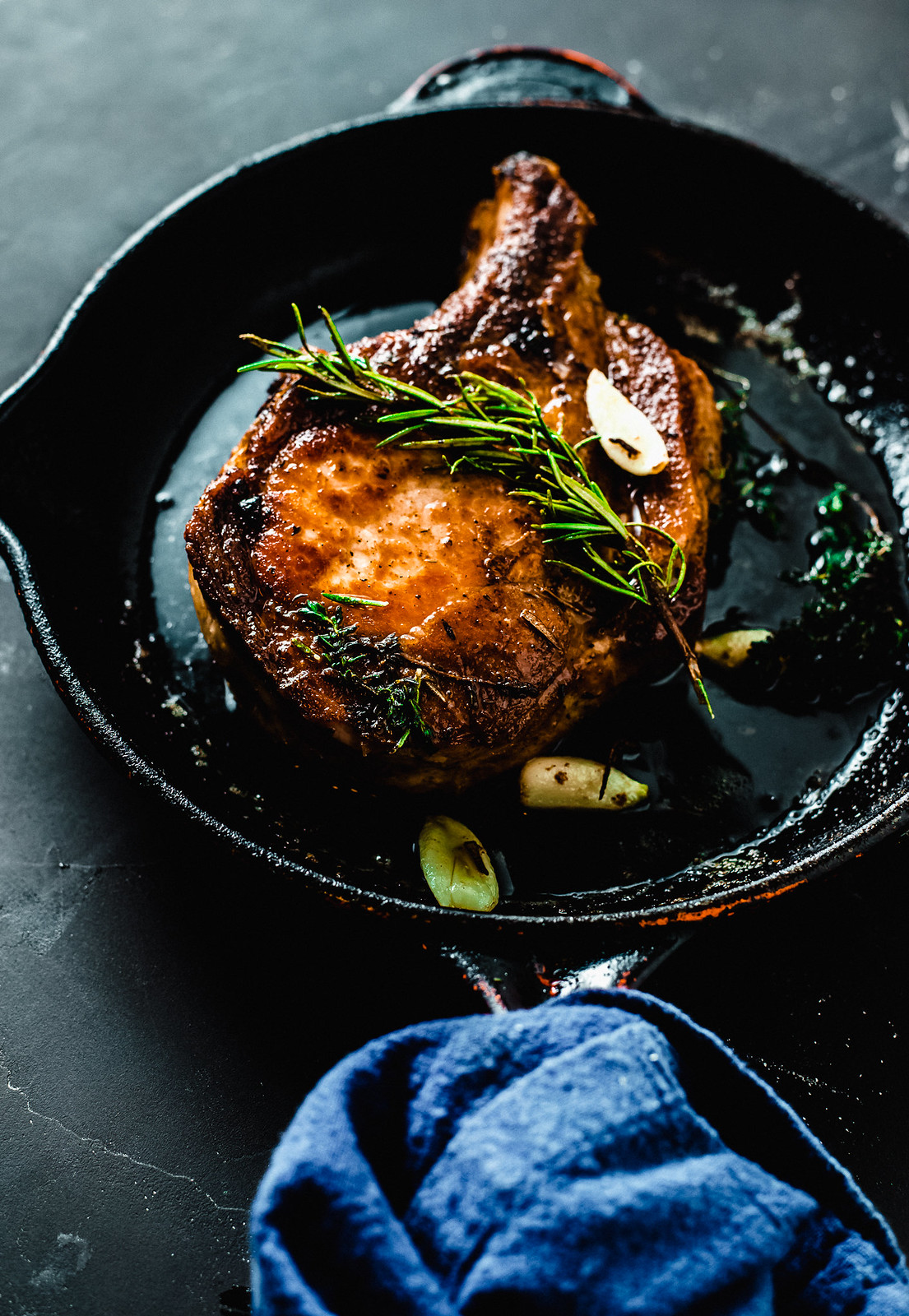Cast iron seared thick cut pork chops are seasoned simply with salt and pepper before being basted with herbs, garlic and butter.

Next to a good seared chicken thigh, bone in pork chops are one of my absolute favorite proteins. When done right, pork chops are incredibly juicy, tender and full of fantastic flavor. And of course, basting the chops with butter, garlic and herbs definitely helps a bit.
Bone in or Boneless Pork Chops?
I personally love a thick bone in pork chop. They do take a bit longer to cook through, but the thickness ensures that the chops are not overcooked and they can handle a strong sear on the cast iron.
Pan Seared Pork Chops in Cast Iron
One of my favorite kitchen tools, a well used and seasoned cast iron pan is the true star in creating the most mouth watering, juicy, pan seared pork chops.
Because this recipe does have a few steps on starting on the stove, then cooking the pork chops in the oven and finally basting on the stove, a cast iron is perfect for the different cooking methods.

It Takes a Few Steps to Make the Best Skillet Pork Chops
This is not a set it and forget it type of recipe, these pork chops do take a bit of cooking skill but I promise if you read through the recipe and follow accordingly, they will come out absolutely perfect!
Start by removing the pork chops from the fridge and bringing it closer to room temperature for 20-30 minutes.
Season with salt and pepper on all sides and get your cast iron pan hot on the stove top.
Pre-heat the oven to 400 degrees Fahrenheit and drizzle the skillet with a neutral oil, such as grapeseed oil
Sear pork chops on all sides, about 2 minutes per side until nicely charred then place in oven and roast for about 6-8 minutes until internal temp reaches 135 degrees Fahrenheit (mostly cooked through).
Then place the skillet back on the stove top and add butter, garlic and herbs and as soon as butter melts, carefully tilt the pan with one hand and use your other hand to baste the infused butter onto the pork chop for another 1-2 minutes, not letting the butter burn.
Once done, turn off heat and remove pork chop to another plate to rest for 10 minutes.
How to Tell When Pork Chops are Done
The best way to tell if a pork chop is done, is to use an internal meat thermometer and cook the pork chops until 140 degrees Fahrenheit.
After you remove the meat from the pan and let it rest for 10 minutes, it will come up a few degrees more to the proper internal temp of 145 degrees Fahrenheit.

What to Serve with Pork Chops
Roasted Kabocha Squash with Coconut Oil and Fried Sage
Italian Style Peppers and Onions

Pan Seared Pork Chops with Garlic and Thyme
LittleFerraroKitchen.com
Equipment
Ingredients
- 1 bone in double cut pork chop, about 2 inches thick
- Salt and pepper
- 2 tablespoon grapeseed oil for drizzling
- 2 tablespoon unsalted butter
- 3-4 garlic cloves gently crushed and skins removed
- 1-2 sprigs of rosemary and thyme
Instructions
- Start by removing the pork chops from the fridge and bringing it closer to room temperature for 20-30 minutes.
- Season the pork chops with salt and pepper on all sides and get your cast iron pan hot on the stove top.
- Pre-heat the oven to 400 degrees Fahrenheit and drizzle the skillet with a neutral oil, such as grapeseed oil
- Once skillet is hot, sear pork chops on all sides, about 2 minutes per side until nicely charred, then place in oven and roast for about 6-8 minutes until internal temp reaches 135 degrees Fahrenheit (mostly cooked through).
- Place the skillet back on the stove top and add butter, garlic and herbs and as soon as butter melts, carefully tilt the pan with one hand and use your other hand to baste the infused butter onto the pork chop for another 1-2 minutes, not letting the butter burn.
- Once done, turn off heat and remove pork chop to another plate to rest for 10 minutes before slicing into it.
Notes
- With any meat, allow it to come closer to room temperature and take it out of the fridge at least 10 minutes before cooking.
- Use any herbs that you have on hand, such as rosemary, thyme, oregano or sage.






Leave a Reply